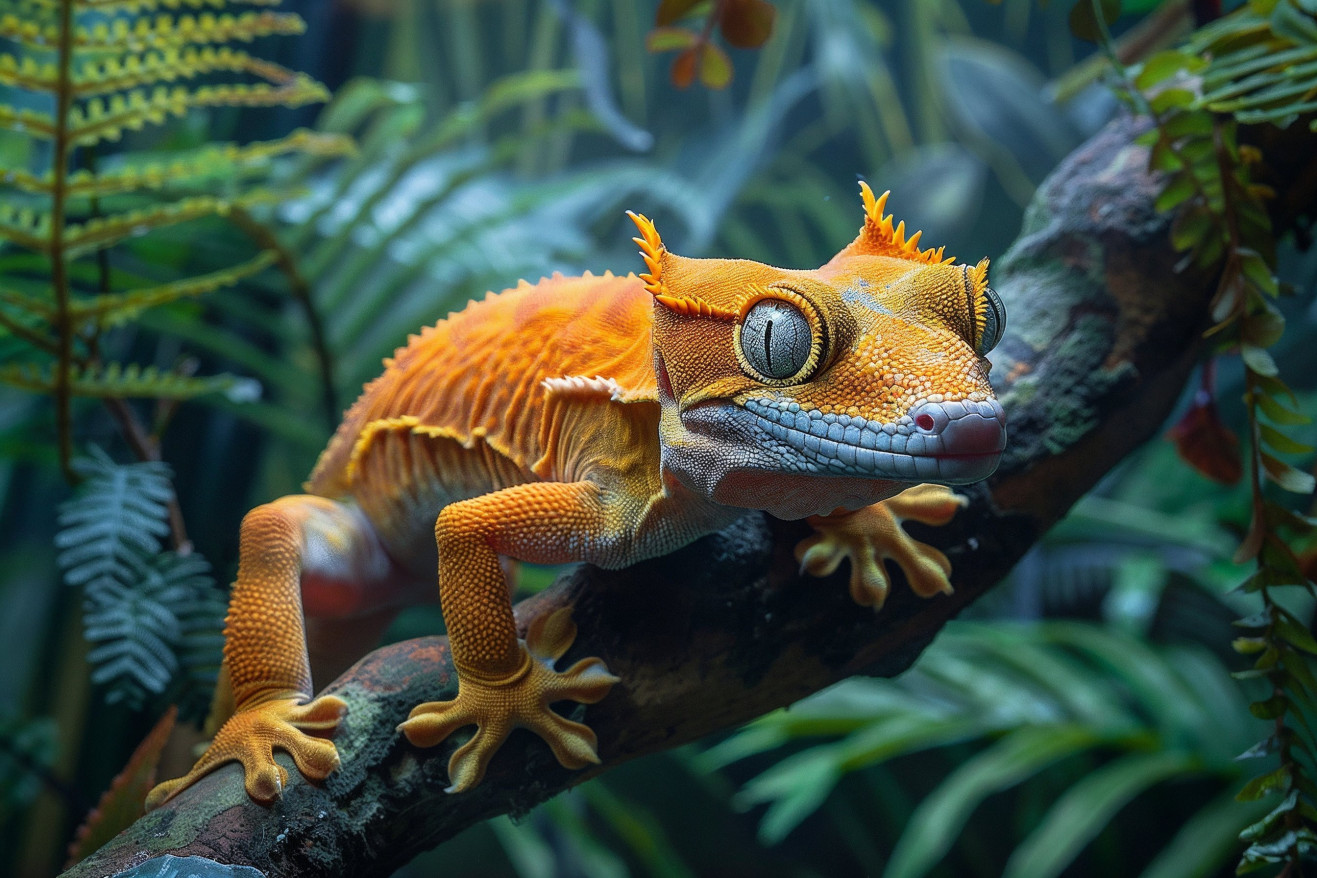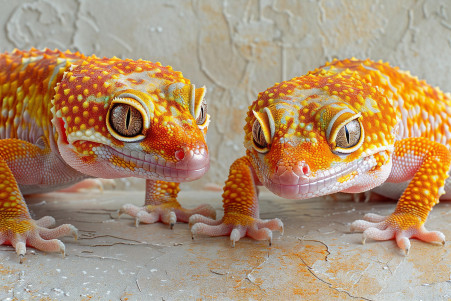How Big Do Crested Geckos Get? Understanding Their Growth
11 June 2024 • Updated 10 June 2024

Crested geckos are a popular pet reptile, but how big do these interesting lizards actually get? Crested geckos usually grow to be between 6-8 inches long, although the largest males can grow to be up to 10 inches. This means that crested geckos are a reptile that can be easily managed and don't require a large enclosure, although they do need plenty of room to climb and explore.
In this article, we'll take a deep dive into crested gecko size, including a look at how fast they grow, the maximum sizes of males and females, how their environment and diet can affect their size, and we'll also talk about some of the myths surrounding miniature and giant crested gecko morphs. Knowing how big crested geckos can get is important for ensuring that you can house these interesting geckos properly and that they can be healthy and happy in captivity.
How Big Do Crested Geckos Get?
Growth Rates and Size Milestones
When they first hatch, crested geckos are very small, measuring just 2.5-3 inches long and weighing around 2 grams. However, crested geckos grow rapidly during their first year of life, and by the time they reach adulthood, they will have reached their full size.
As noted by CB Reptile, under the right conditions, crested geckos will typically grow to 6-7 inches in length and 40-50 grams by the time they are 12-18 months old, which is when they are considered young adults. However, growth rates can be influenced by a number of factors including diet, environmental conditions, and genetics, so some crested geckos may reach this stage earlier or later than others.
Owners should make sure to keep an eye on their crested gecko's growth and development, including weight and length, to make sure they are on track. This includes making sure they are in the right environmental conditions, including temperatures between 68-77°F and high humidity, and are being fed a nutritious diet that includes calcium and other essential nutrients. This will help ensure they grow from a tiny hatchling to a full-sized adult crested gecko.
Size Differences: Males vs. Females
Although crested geckos generally range from 6-8 inches in size, there are some size differences between males and females. According to Petopedia, male crested geckos are larger than females, and some males can grow to be especially large, up to 10 inches in length. Meanwhile, females are generally smaller, and according to The Ultimate Guide to Crested Geckos, they rarely grow to be longer than 8 inches.
The difference in size between males and females becomes more noticeable as the geckos age and grow to their full adult size. Being aware of these differences can help owners make sure they are providing the right kind of housing and care for their crested gecko based on its sex. For example, if males are larger, their enclosures may need to be taller to accommodate their longer bodies.
Habitat and Diet: Factors That Impact Size
There are several factors that can impact the size of a crested gecko, including the environment in which it lives and the quality of its diet. According to CB Reptile, the right temperature and humidity levels are important for healthy growth and development. Crested geckos thrive in temperatures ranging from 68-77°F, with 73-74°F being the ideal temperature. Temperatures over 80°F can be harmful to crested geckos if they are exposed to them for long periods of time.
A diet that includes calcium, vitamins, and other nutrients that are important for growth and development can help the gecko grow to a larger size. As mentioned by the Warren Woods Veterinary Hospital, crested geckos need to be supplemented with calcium because they don’t produce enough of it on their own. A commercial crested gecko diet, supplemented with crickets and worms every so often, can help ensure that the gecko gets the nutrients it needs.
If the habitat isn’t right or the gecko isn’t getting the nutrients it needs from its diet, it can lead to stunted growth, which can result in smaller-than-average crested geckos. It’s important to make sure that the gecko is being kept in an environment with the right temperature, humidity, and diet so that it can grow to its full potential.
Crested Gecko Morphs and Size
Crested geckos have a wide range of color and pattern morphs, some of which can affect the size of the gecko. According to Fringemorphs, most morphs will be in the 6-8 inch range, but some morphs like the Lilly White or Axanthic may produce slightly smaller animals. On the other hand, Terrarium Quest explains that other morphs, such as the Tiger or Brindle, have not been shown to have a significant impact on size when compared to the standard crested gecko.
Selective breeding by reptile breeders has resulted in many new and unique crested gecko morphs, as shown by Fluffydragons. Knowing the potential size differences between different morphs can help people choose the right pet for them. Whether a potential owner wants a larger male or a smaller female, understanding how a gecko's morph can affect its size can help ensure that the right care and environment is provided.
How to Take Care of Baby and Young Crested Geckos
Baby crested geckos need special care because they are so small and delicate. According to Pangea Reptile LLC, babies should be kept in smaller enclosures with fewer items to make sure they don't get hurt and can easily find their food and water. MyCrestedGecko.com suggests using small plastic bins or terrariums that are no bigger than 8"x8"x12" for babies up to 4 months old.
It's also important to make sure the humidity is kept high, between 60-70%, to help babies shed and avoid dehydration, according to BeWild Rescue. In addition to a diet of small, appropriately sized insects or commercial crested gecko diets, babies need to be given calcium and vitamin supplements to make sure they grow up healthy.
Babies should be handled as little as possible for the first few weeks so they can get used to their new home and not get stressed out. Pangea Reptile LLC recommends waiting 1-2 weeks after getting a baby crested gecko to start handling it. With the right care, diet, and as little handling as possible, baby crested geckos can grow up to be healthy adults.
Health Monitoring and Size-Related Concerns
Regular health monitoring is important to ensure that crested geckos are eating, growing, and behaving normally. This way, any potential health issues that could impact their size and development can be caught early. For example, ReptiFiles explains that sudden weight loss, lethargy, and a lack of appetite are all signs of health issues that could lead to stunted growth or a smaller size.
Metabolic bone disease, which is caused by a lack of calcium, can lead to stunted growth and deformities if it’s not treated. And while calcium deficiency is rare in crested geckos that are fed a proper diet, AC Reptiles points out that it can be a serious issue and in many cases, life threatening. Therefore, it’s important to take crested geckos to the vet and treat any health issues that arise to ensure that they grow and develop properly.
In addition to health monitoring, providing the right habitat, diet, and keeping an eye out for any signs of illness can help prevent size-related concerns in crested geckos. By being proactive and taking their crested geckos to the vet if they suspect that they’re sick, owners can help their pets grow to their full size and live long, healthy lives.
Conclusion: Understanding Crested Gecko Size
Crested geckos are one of the most popular reptile pets because of their small size. Most crested geckos grow to between 6-8 inches in length. According to Petopedia, adult crested geckos can grow up to 10 inches long, but this is more common in larger males.
While size is influenced by sex, environmental factors, diet, and genetics, their small size makes them easy to keep in captivity. CB Reptile explains that with the right care, crested geckos will typically be 6-7 inches and 40-50 grams by 12-18 months, which is when they reach young adulthood.
Knowing and meeting their size requirements is important to make sure they stay healthy and happy in captivity. Whether you have a larger male or a smaller female, it’s important to make sure you have the right size enclosure, feed them properly, and keep an eye on their size and weight.
By understanding and meeting the unique size and care requirements of crested geckos, you can have a fulfilling and successful experience as a pet owner while also ensuring the well-being of these amazing reptiles.


